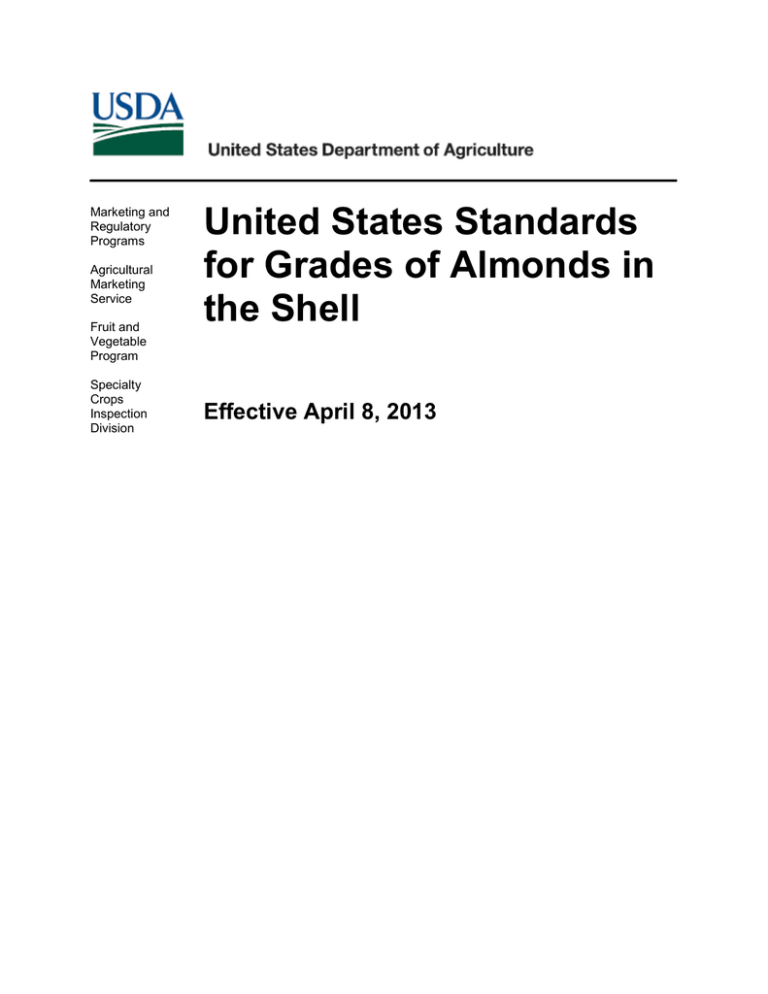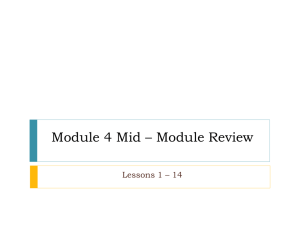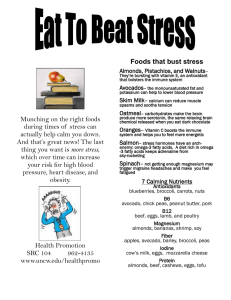United States Standards for Grades of Almonds in the Shell
advertisement

Marketing and Regulatory Programs Agricultural Marketing Service Fruit and Vegetable Program Specialty Crops Inspection Division United U States Standards for Grades of Almonds in the Shell Effective April 8, 2013 This is the fourth issue, as amended, of the United States Standards for Grades of Almonds in the Shell published in the FEDERAL REGISTER of March 8, 2013 (78 FR 14907) to become effective April 8, 2013. This issue supersedes the third issue, which has been in effect since March 24, 1997. Voluntary U.S. grade standards are issued under the authority of the Agricultural Marketing Act of 1946, which provides for the development of official U.S. grades to designate different levels of quality. These grade standards are available for use by producers, suppliers, buyers, and consumers. As in the case of other standards for grades of fresh and processed fruits and vegetables, these standards are designed to facilitate orderly marketing by providing a convenient basis for buying and selling, for establishing quality control programs, and for determining loan values. The U.S. grade standards, grading manuals, handbooks or instructions for inspection of several fresh and processed fruits and vegetables are available on the internet and upon request at the address below. These manuals or instructions contain detailed interpretations of the grade standards and provide step-by-step procedures for grading the product. Grade standards are issued by the Department after careful consideration of all data and views submitted, and the Department welcomes suggestions which might aid in improving the standards in future revisions. Comments may be submitted to, and copies of standards and grading manuals obtained from: Director, Specialty Crops Inspection Division Fruit and Vegetable Program, AMS, U.S. Department of Agriculture 1400 Independence Avenue, SW, STOP 0240 Washington, D.C. 20250 Phone: (202) 720-5870 Fax: (202) 720-0393 _______________________________________________________________________ Authority: 7 U.S.C. 1621-1627. Note: Compliance with the provisions of these standards shall not excuse failure to comply with the provisions of the Federal Food, Drug, and Cosmetic Act, or with applicable State laws and regulations. Non-Discrimination Policy: The U.S. Department of Agriculture (USDA) prohibits discrimination against its customers, employees, and applicants for employment on the bases of race, color, national origin, age, disability, sex, gender identity, religion, reprisal, and where applicable, political beliefs, marital status, familial or parental status, sexual orientation, or all or part of an individual's income is derived from any public assistance program, or protected genetic information in employment or in any program or activity conducted or funded by the Department. (Not all prohibited bases will apply to all programs and/or employment activities.) To File an Employment Complaint: If you wish to file an employment complaint, you must contact your agency's EEO Counselor (PDF) within 45 days of the date of the alleged discriminatory act, event, or in the case of a personnel action. Additional information can be found online at http://www.ascr.usda.gov/complaint_filing_file.html. To File a Program Complaint: If you wish to file a Civil Rights program complaint of discrimination, complete the USDA Program Discrimination Complaint Form (PDF), found online at http://www.ascr.usda.gov/complaint_filing_cust.html, or at any USDA office, or call (866) 632-9992 to request the form. You may also write a letter containing all of the information requested in the form. Send your completed complaint form or letter to us by mail at U.S. Department of Agriculture, Director, Office of Adjudication, 1400 Independence Avenue, S.W., Washington, D.C. 202509410, by fax (202) 690-7442 or email at program.intake@usda.gov. Persons with Disabilities: Individuals who are deaf, hard of hearing or have speech disabilities and you wish to file either an EEO or program complaint please contact USDA through the Federal Relay Service at (800) 877-8339 or (800) 845-6136 (in Spanish). Persons with disabilities who wish to file a program complaint, please see information above on how to contact us by mail directly or by email. If you require alternative means of communication for program information (e.g., Braille, large print, audiotape, etc.) please contact USDA's TARGET Center at (202) 720-2600 (voice and TDD). United States Standards for Grades of Almonds in the Shell Section Page No. Grades 2 §51.2075 U.S. No. 1. 2 §51.2076 U.S. No. 1 Mixed. 2 §51.2077 U.S. No. 2. 3 §51.2078 U.S. No. 2 Mixed. 3 Application of Tolerances 3 §51.2079 3 Application of tolerances. Determination of Grade 3 §51.2080 3 Determination of grade. Definitions 3 §51.2081 Similar varietal characteristics. 3 §51.2082 Loose extraneous and foreign material. 3 §51.2083 Clean. 4 §51.2084 Fairly bright. 4 §51.2085 Fairly uniform color. 4 §51.2086 Well dried. 4 §51.2087 Decay. 4 §51.2088 Rancidity. 4 §51.2089 Damage. 4 §51.2090 Serious damage. 5 §51.2091 Thickness. 5 United States Standards for Grades of Almonds in the Shell (April 8, 2013) 1 Grades §51.2075 U.S. No. 1. "U.S. No. 1" consists of almonds in the shell which are of similar varietal characteristics and free from loose extraneous and foreign material. The shells are clean, fairly bright, fairly uniform color, and free from damage caused by discoloration, adhering hulls, broken shells or other means. The kernels are well dried, free from decay, rancidity, and free from damage caused by insects, mold, gum, skin discoloration, shriveling, brown spot or other means. (a) Unless otherwise specified, the almonds are of a size not less than 28/64 of an inch (11.1 mm) in thickness. (b) In order to allow for variations incident to proper grading and handling, the following tolerances are provided as specified: (1) For external (shell) defects. 10 percent, by count, for almonds which fail to meet the requirements of this grade other than for variety and size; (2) For dissimilar varieties. 5 percent, by count, including therein not more than 1 percent for bitter almonds mixed with sweet almonds; (3) For size. 5 percent, by count, for almonds which are smaller than the specified minimum thickness; (4) For loose extraneous and foreign material. 2 percent, by weight, including therein not more than 1 percent which can pass through a round opening 24/64 inch (9.5 mm) in diameter: Provided, that such material is practically free from insect infestation; and, (5) For internal (kernel) defects. 10 percent, by weight, for almonds with kernels failing to meet the requirements of this grade: Provided, that not more than onehalf of this tolerance or 5 percent shall be allowed for kernels affected by decay or rancidity, damaged by insects or mold or seriously damaged by shriveling: And provided further, that no part of this tolerance shall be allowed for live insects inside the shell. §51.2076 U.S. No. 1 Mixed. "U.S. No. 1 Mixed" consists of almonds in the shell which meet the requirements of U.S. No. 1 grade, except that two or more varieties of sweet almonds are mixed. United States Standards for Grades of Almonds in the Shell (April 8, 2013) 2 §51.2077 U.S. No. 2. "U.S. No. 2" consists of almonds in the shell which meet the requirements of U.S. No. 1 grade, except that an additional tolerance of 20 percent shall be allowed for almonds with shells damaged by discoloration. §51.2078 U.S. No. 2 Mixed. "U.S. No. 2 Mixed" consists of almonds in the shell which meet the requirements of U.S. No. 2 grade, except that two or more varieties of sweet almonds are mixed. Application of Tolerances §51.2079 Application of tolerances. The tolerances for the foregoing grades are applied to the entire lot of almonds, based upon a composite sample drawn from containers throughout the lot. Determination of Grade §51.2080 Determination of grade. In grading the inspection sample, the percentage of loose hulls, pieces of shell, chaff and foreign material is determined on the basis of weight. Next, the percentages of nuts which are of dissimilar varieties, undersize or have adhering hulls or defective shells are determined by count, using an adequate portion of the total sample. Finally, the nuts in that portion of the sample are cracked, and the percentage having internal defects is determined on the basis of weight. Definitions §51.2081 Similar varietal characteristics. "Similar varietal characteristics" means that the almonds are similar in shape, and are reasonably uniform in degree of hardness of the shells, and that bitter almonds are not mixed with sweet almonds. For example, hard-shelled varieties, semi-soft shelled varieties, soft-shelled varieties and paper-shelled varieties are not mixed together, nor are any two of these types mixed under this definition. §51.2082 Loose extraneous and foreign material. "Loose extraneous and foreign material" means loose hulls, empty broken shells, pieces of shells, external insect infestation and any substance other than almonds in the shell or almond kernels. United States Standards for Grades of Almonds in the Shell (April 8, 2013) 3 §51.2083 Clean. "Clean" means that the shell is practically free from dirt and other adhering foreign material. §51.2084 Fairly bright. "Fairly bright" means that the shells show good characteristic color. §51.2085 Fairly uniform color. "Fairly uniform color" means that the shells do not show excessive variation in color, whether bleached or natural. §51.2086 Well dried. "Well dried" means that the kernel is firm and brittle, not pliable or leathery. §51.2087 Decay. "Decay" means that part or all of the kernel has become decomposed. §51.2088 Rancidity. "Rancidity" means that the kernel is noticeably rancid to taste. §51.2089 Damage. "Damage" means any defect which materially detracts from the appearance of the individual kernel, or the edible or shipping quality of the almond. Any one of the following defects or combination thereof, the seriousness of which exceeds the maximum allowed for any one defect shall be considered as damage: (a) Discoloration of the shell which is medium gray to black and affects more than one-eighth of the surface in the aggregate. Normal variations of a reddish or brownish color shall not be considered discoloration; (b) Adhering hulls which cover more than 5 percent of the shell surface in the aggregate; (c) Broken shells when a portion of the shell is missing, or the shell is broken or fractured to the extent that moderate pressure will permit the kernel to become dislodged; United States Standards for Grades of Almonds in the Shell (April 8, 2013) 4 (d) Insect injury when the insect, web or frass is present or there is definite evidence of insect feeding; (e) Mold, when visible on the kernel, except when white or gray and easily rubbed off with the fingers; (f) Gum, when a film of shiny, resinous appearing substance affects an area aggregating more than the equivalent of a circle one-quarter inch (6.4 mm) in diameter; (g) Skin discoloration when more than one-half of the surface of the kernel is affected by very dark or black stains contrasting with the natural color of the skin; (h) Shriveling when the kernel is excessively thin for its size, or when materially withered, shrunken, leathery, tough or only partially developed: Provided, that partially developed kernels are not considered damaged if more than threefourths of the pellicle is filled with meat. An almond containing two kernels shall not be classed as damaged if either kernel has more than three-fourths of the pellicle filled with meat; and, (i) Brown spot which affects an aggregate area on the kernel greater than the area of a circle one-eighth inch (3.2 mm) in diameter. §51.2090 Serious damage. "Serious damage" means any defect which makes a kernel or piece of kernel unsuitable for human consumption, and includes decay, rancidity, insect injury and damage by mold. The following defect shall be considered as serious damage: Shriveling when the kernel is seriously withered, shrunken, leathery, tough or only partially developed: Provided, that partially developed kernels are not considered seriously damaged if more than one-fourth of the pellicle is filled with meat. §51.2091 Thickness. "Thickness" means the greatest dimension between the two semi-flat surfaces of the shell measured at right angles to a plane extending between the seams of the shell. United States Standards for Grades of Almonds in the Shell (April 8, 2013) 5


